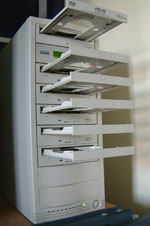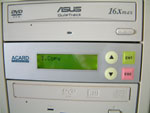|
Duplication.
 |
Cassette duplication is easy - put the master
in one slot, the blanks in the other slots, and hit a button.
CD duplication can be just as easy, but there are many more
options to consider. Perhaps the most important consideration
is whether or not to include printing as part of the duplication
process.
Blank CD's can be purchased with a printable surface - they
look very like any other CD, accept that the surface looks
slightly dull, rather than glossy. Using special printers,
these discs can be printed to look just as professional as
any commercially produced product. Many manufacturers now
offer combined copier/printers, which duplicate the CD's,
and print them as one process. This is certainly a convenient
solution, and if space is at a premium, may be worth considering.
Apart from that, there are good reasons why it is better to
consider separate printers and copiers.
Combined units tend to be more complex than separates - apart
from the lowest cost models, the "robotics" for
moving discs between copy drives and print mechanism are complicated.
This means that mechanical problems are more likely, and if
they do occur, then the complete (usually bulky) copy system
needs to be returned for repair. On the other hand, separate
printers are less complex, as are the copiers - problems are
less likely, and if something does go wrong, repair will be
much easier and less costly. (Most copiers use "off the
shelf" CD writer drives, available from computer suppliers.
Repair may be a simple "do it yourself" job - screwing
out one drive and replacing it with another).
 |
The copier and printer you choose will depend
both on your budget, and the number of CD's you need to copy.
The simplest printers take in only one disc at a time, so
every single disc needs to be manually loaded. If you only
intend copying around a dozen discs each week, this is fine,
however if your requirements are greater than this, then you
need to consider a printer which can be loaded with a stack
of discs. The smallest capacity is usually up to 25 discs,
though printers are available with capacities of several hundred
blanks.
Although there are a range of print technologies available,
the most common is inkjet. Just like the inkjet printer attached
to most domestic computers, this "sprays" tiny droplets
of ink onto the print surface. This is the reason that "printable"
discs must be used - some people have discovered to their
cost that using slightly cheaper "white top" discs
which are not "printable", is not an option! The
ink just sits on the surface of these discs, and does not
dry - the result is a messed up print job and ink everywhere
but where it should be! Printable discs cost only a few pence
more than standard discs, and are essential. (The main competitor
to inkjet printing is thermal printing, which uses standard
discs, but is still more expensive in terms of running costs
than inkjet).
Printing may be carried out before duplication, and some people
will choose to work this way. They can then use pre-printed
discs for duplication immediately after a church service,
and have completed CD's ready for people to take home with
them only minutes after the service ends! Most however, choose
to duplicate first and then print. This reduces the chances
of duplication failures, which although not frequent, do mean
that discs are wasted.
 |
One-to-one copiers are available,
and once again for the budget conscious, good deals are available.
However copying large numbers of discs this way is very time
consuming, and most users opt for more efficient one-to-many
copiers. A one-to-five copier, with discs running at x52 speed,
is capable of duplicating around 80 discs per hour. Most lower
cost duplicators need to be attended - the operator places
blank discs into each drive, presses copy, then waits for
the copy process to complete before starting the next lot.
In this respect they are very like cassette duplicators. For
anyone duplicating large quantities, "robotic" copiers
are available which can run unattended, with capacities of
around 100 discs. They are however slower at copying each
disc - a full run could take several hours. This is because
at the lower end of the market, they have only a single copying
drive. For those who need speed, large quantities, and unattended
operation, multi-drive robotic copiers are available which
can duplicate over 1000 discs per day - but these cost several
thousand pounds each.
A further option is to include a hard disc drive in the copier.
This allows the user to store "images" of CD's,
and recall them for duplication. This reduces wear and tear
on the master drive, and means that CD's can be duplicated
without having to retain and catalogue multiple master discs.
> Cost
|